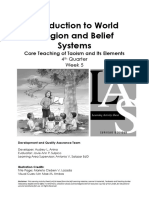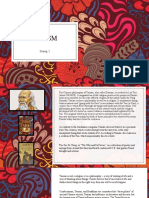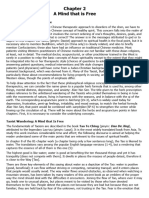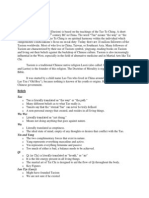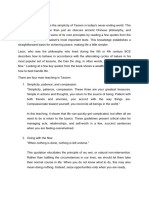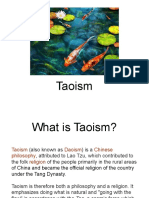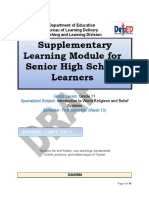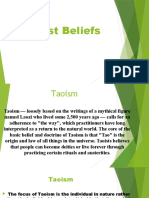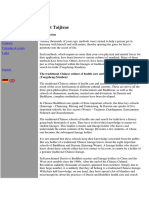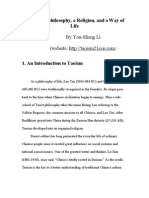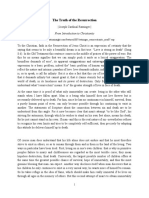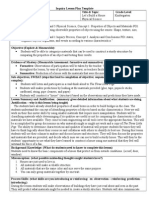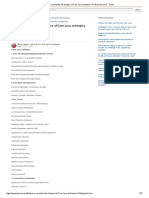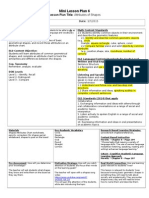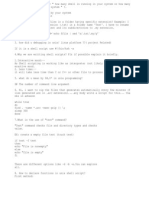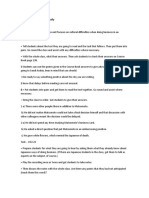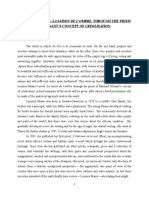YIN-YANG THOUGHT A good reason to believe that Lao-Tzu was not the author of the Tao-Te-Ching is that the
core philosophy of Taoism
grew up from the peasant class during the Shang Dynasty (1600-1046 BCE) long before the accepted dates for Lao-Tzu. During the Shang
era, the practice of divination became more popular through the reading of oracle bones which would tell one's future. Reading oracle
bones led to a written text called the I-Ching (c. 1250-1150 BCE), the Book of Changes, which is a book still available today providing a
reader with interpretations for certain hexagrams which supposedly tell the future. A person would ask a question and then throw a
handful of yarrow sticks onto a flat surface (such as a table) and the I-Ching would be consulted for an answer to the person's question.
These hexagrams consist of six unbroken lines (called Yang lines) and six broken lines (Yin). When a person looked at the pattern the yarrow
sticks made when they were thrown, and then consulted the hexagrams in the book, they would have their answer. The broken and the
unbroken lines, the yin and yang, were both necessary for that answer because the principles of yin and yang were necessary for life.
Historian John M. Koller writes: Yin-yang thought began as an attempt to answer the question of the origin of the universe. According to
yin-yang thought, the universe came to be as a result of the interactions between the two primordial opposing forces of yin and yang.
Because things are experienced as changing, as processes coming into being and passing out of being, they must have both yang, or being,
and yin, or lack of being. The world of changing things that constitutes nature can exist only when there are both yang and yin. Without
yang nothing can come into existence. Without yin nothing can pass out of existence (207). Although Taoism and the Tao-Te-Ching were
not originally associated with the symbol known as the yin-yang, they have both come to be because the philosophy of Taoism embodies
the yin-yang principle and yin-yang thought. Life is supposed to be lived in balance, as the symbol of the yin and the yang expresses. The
yin-yang is a symbol of opposites in balance - dark/light, passive/aggressive, female/male - everything except good and evil, life and death,
because nature does not recognize anything as good or evil and nature does not recognize a difference between life and non-life. All is in
harmony in nature, and Taoism tries to encourage people to accept and live that kind of harmony as well.
‘Wu wei’ does not signify not acting at all, but rather not forcing things on their way. Wu wei signifies that the action should be
immediately in accordance with the Tao, hence the necessary will be done without exaggeration, hyperbole or over eagerness as these are
considered obstructive, though rather in an easy, facile, non-disturbing way, leading to overall harmony and balance. It is a state of inner
tranquility, which will show the right effortless action at the right time. (i.e. the harmonious complexity of natural ecosystems- the tao-
works well without man made changes- wu wei). Wu wei could be characterized by the adaptability of the flow of water in a stream. I.e.
Water flows without awareness, or naturally, downriver (principle of tao). It might be blocked by an object (branch or stone), though
without contriving to do so, finds it way around the object. Water acts without motive, it acts with wu wei. If one wants to travel on water,
one will use a boat or ship, since it is suitable as she moves around adequately on water. If one wants to walk on land, a boat is not suitable
to move around. One will only be annoyed and only have difficulties, not gaining anything but inflicting damage to oneself.) The wu wei is
characterized by an activity undertaken to perceive the Tao within all things and to conform oneself to its "way." The practice and efficacy
of wu wei are fundamental in Taoist thought. The goal of ‘wu wei’ is alignment with Tao, revealing the soft and invisible power within all
things.
LONGEVITY AND CHI According to some interpretations of the Tao Te Ching, is “to live the longest possible natural life by living in harmony
with one’s social and natural environment.” (Adler 2002, 47). In light of this, some Taoist practices aim to prolong and enhance the life
force or the chi of the person. One of them is the “internal alchemy”.” The "chi" energy is believed to be the life-breath of the universe. It is
within and around each person. People are born with all the chi they will need for their lifetimes. Often, people will do exercises to help
preserve their chi, therefore extending their lifetimes.
BELIEFS AND RELATED ISSUES IN TAOISM Other Chinese texts relating to Taoism are the Chaung-Tzu (also known as the Zhuangzi, written
by Zhuang Zhou, c. 369-286 BCE) and the Daozang from the Tang Dynasty (618-907 CE) and Sung Dynasty (960-1234 CE) which was
compiled in the later Ming Dynasty (1368- 1644 CE). All of these texts are based on the same kinds of observation of the natural world and
the belief that human beings are innately good and only needed a reminder of their inner nature to pursue virtue over vice. There are no
"bad people" according to Taoist principles, only people who behave badly. Given the proper education and guidance toward
understanding how the universe works, anyone could be a "good person" living in harmony with the earth and with others. According to
this belief, the way of the Tao is in accordance with nature while resistance to the Tao is unnatural and causes friction. The best way for a
person to live, according to Taoism, is to submit to whatever life brings and be flexible. If a person adapts to the changes in life easily, that
person will be happy; if a person resists the changes in life, that person will be unhappy. One's ultimate goal is to live at peace with the way
of the Tao and recognize that everything that happens in life should be accepted as part of the eternal force which binds and moves
through all things. This philosophy corresponds closely with the Logos of the Roman stoics like Epictetus and Marcus Aurelius. They claimed
the Logos was a force of reason and accepted as part of the eternal force which binds and moves through all things. This philosophy
corresponds closely with the Logos of the Roman stoics like Epictetus and Marcus Aurelius. They claimed the Logos was a force of reason
and that nothing which happened according to the Logos could be bad; only people's interpretations of what happened made those
circumstances seem bad. Taoism claims the same thing: nothing is bad in itself, only our self-interest makes us think that some events in life
are bad and others good. Actually, all things happen in accordance with the flow of the Tao and, since the Tao is natural, all things are
natural. Unlike Buddhism (which came from India but became very popular in China), Taoism arose from the observations and beliefs of the
Chinese people. The principles of Taoism impacted Chinese culture greatly because it came from the people themselves and was a natural
expression of the way the Chinese understood the universe. The concept of the importance of a harmonious existence of balance fit well
�with the equally popular philosophy of Confucianism (also native to China). Taoism and Confucianism were aligned in their view of the
innate goodness of human beings but differed in how to bring that goodness to the surface and lead people to act in better, unselfish, ways.
TAOISM & CONFUCIANISM The philosophy of Taoism grew into a religion of the peasant classes of the Shang Dynasty, who lived closely
with nature. Their observations of the natural world influenced their philosophy, and one of the things they incorporated was the concept
of eternity. The tree which seemed to die came back to life in the spring season and the grass grew again. They concluded that when
people died they went somewhere else where they continued to live, they did not just disappear. Everyone's ancestor who had ever died
still lived on in another place and in the presence of the gods; Confucians believed in this same concept and revered their ancestors as part
of their daily practices. Ancestor worship became a part of Taoist rituals, although the Tao-Te-Ching does not support it outright, and a
reverence for nature and the spirits in nature - very similar to the Shintoism of Japan - came to characterize Taoist observances. Even
though Taoism and Confucianism are very similar in many core beliefs, they are different in significant ways. A refusal to participate in strict
rites and rituals sets Taoism apart most dramatically from the philosophy of Confucius. Koller writes: Confucius advocated rites and music
so that the desires and emotions might be developed and regulated, for therein lay the development of humanity. To Lao-Tzu, efforts to
develop and regulate the desires and emotions seemed artificial, tending to interfere with the harmony of nature. Rather than organize and
regulate things to achieve perfection, Lao-Tzu advocated letting things work to their perfection naturally. This means supporting all things in
their natural state, allowing them to transform spontaneously (245). To Lao-Tzu (the name is used here as an expression of Taoist thought),
the more regulations one demanded, the harder one made one's life and the lives of others. If one relaxed the artificial rules and
regulations which were supposed to improve life, only then would one find that life naturally regulates itself and one would fall into pace
with the Tao which runs through and regulates and binds and releases all things naturally.
RITUALS This belief in allowing life to unfold in accordance with the Tao does not extend to Taoist rituals, however. The rituals of Taoist
practice are absolutely in accordance with the Taoist understanding but have been influenced by Buddhist and Confucian practices so that,
in the present day, they are sometimes quite elaborate. Every prayer and spell which makes up a Taoist ritual or festival must be spoken
precisely and every step of the ritual observed perfectly. Taoist religious festivals are presided over by a Grand Master (a kind of High
Priest) who officiates, and these celebrations can last anywhere from a few days to over a week. During the ritual, the Grand Master and his
assistants must perform every action and recitation in accordance with tradition or else their efforts are wasted. This is an interesting
departure from the usual Taoist understanding of "going with the flow" and not worrying about external rules or elaborate religious
practices. Taoist rituals are concerned with honoring the ancestors of a village, community, or city, and the Grand Master will invoke the
spirits of these ancestors while incense burns to purify the area. Purification is a very important element throughout the ritual. The
common space of everyday life must be transformed into sacred space to invite communion with the spirits and the gods. There are usually
four assistants who attend the Grand Master in different capacities, either as musicians, sacred dancers, or readers. The Grand Master will
act out the text as read by one of his assistants, and this text has to do with the ascent of the soul to join with the gods and one's ancestors.
In ancient times, the ritual was performed on a staircase leading to an altar to symbolize ascent from one's common surroundings to the
higher elevation of the gods. In the present day, the ritual may be performed on a stage or the ground, and it is understood from the text
and the actions of the Grand Master that he is ascending. The altar still plays an important part in the ritual as it is seen as the place where
the earthly realm meets with the divine. Taoist households have their own private altars where people will pray and honor their ancestors,
household spirits, and the spirits of their village. Taoism encourages individual worship in the home, and the rituals and festivals are
community events which bring people together, but they should not be equated with worship practices of other religions such as attending
church or temple. A Taoist can worship at home without ever attending a festival, and throughout its history most people have. Festivals
are very expensive to stage and are usually funded by members of the town, village, or city. They are usually seen as celebrations of
community, though are sometimes performed in times of need such as an epidemic or financial struggle. The spirits and the gods are
invoked during these times to drive away the dark spirits causing the problems.
Afterlife Taoism doesn't pay close attention to what happens after death, the afterlife. Taoist have an ambition through their whole life
which is immortality. Taoism stresses health and longevity through diet and meditation. Death is nothing but a return to Tao. Taoist were
traditionally not concerned with death because they expected to live forever.
Taoism significantly influenced Chinese culture from the Shang Dynasty forward. The recognition that all things and all people are
connected is expressed in the development of the arts, which reflect the people's understanding of their place in the universe and their
obligation to each other. During the Tang Dynasty, Taoism became the state religion under the reign of the emperor Xuanzong because he
believed it would create harmonious balance in his subjects and, for a while, he was correct. Xuanzong's rule is still considered one of the
most prosperous and stable in the history of China and the high point of the Tang Dynasty. Taoism has been nominated as a state religion a
number of times throughout China's history but the majority preferred the teachings of Confucius (or, at times, Buddhism), most likely
because of the rituals of these beliefs which provide a structure Taoism lacks. Today, Taoism is recognized as one of the great world
religions and continues to be practiced by people in China and throughout the world.












